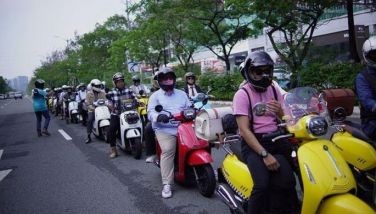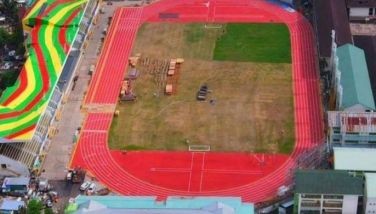River Wild
September 4, 2002 | 12:00am
 The travel advisory from the embassy was simple and clear: Stay away from the north and south portions of of the Philippines; they’re dangerous for tourists.
The travel advisory from the embassy was simple and clear: Stay away from the north and south portions of of the Philippines; they’re dangerous for tourists.
But Hiroshi Ishino knows this country more than those ordinary, camera-toting Japanese travelers. Not that he doesn’t believe the embassy, but he has long realized that there is more to the Philippines than kidnap-for-ransom gangs and bands of communist NPAs.
Ishino has been here for six years. As executive vice president of the biggest truckmaker in this part of the world, he is expected to go to farflung places where Isuzu vehicles and engines are more in-demand, and besides, the sportsman in him simply wouldn’t let any opportunity for adventure go by. So when one of his senior managers brought up the idea of a road trip to Kalinga for white water rafting, he was quick to approve.
Enconced in the center of the Cordilleras, the former subprovince of Kalinga is bounded on the north by the Apayao, on the east by Cagayan, on the west by Abra and on the east by the Mountain Province. Its more than 3,000 kilometer area covers rugged land and mountain peaks and most of it remain inhabited up to this day as majority of its 200,000 residents are concentrated on town centers.
Kalinga is probably the third most enigmatic province in this country, next to Basilan and Sulu in Mindanao. Born with a congenital image problem due to its name, which literally means "headhunters," it has been trying its best all these years to shed its identity as a place besieged by problems of insurgency and tribal wars.
But its main problem really is its distance from Manila. Only 10 years ago, a trip to Kalinga would take you to Baguio, which is only halfway, and you’d pass through trails that are difficult even to the toughest of vehicles.
Those brave enough to explore the territory, however, had come back with stories of adventure never found elsewhere. They brought with them tales of caves with pure gold, forests with a variety of lifeforms, rivers with rapids comparable to those in the Colorado Rockies, and friendly tribesmen who have long forgotten their ancestors’ practice of headhunting.
Over the years, roads were constructed to link Kalinga to other parts of the Cordilleras. This has made things easier for people like Ishino who had to catch up with 25 Isuzu employees and mediamen who left Manila earlier that Friday. On board his Trooper, he journeyed through Nueva Ecija, Nueva Vizcaya, then Isabela – all through the winding roads up and down the Cagayan Valley. From Santiago City in Isabela, after filling up with Shell Diesoline Ultra and meeting with his staff and the media, Ishino’s Trooper convoyed with the other Isuzu vehicles through the highway to Tuguegarao via Ramon town all the way to Tabuk, the capital of Kalinga.
The group stayed at the Davidson Hotel, a small place with 17 rooms and two conference halls. A two-days-two-nights accomodation is part of the package being offered by Adventures and Expeditions Philippines, Inc., whose owners, Anton Carag and the couple Val and Didi Camara are rafting and kayaking experts.
AEPI is an outfitter providing equipment, training and guiding services to those wanting to have a weekend adventure. Its main base is the historic Chico River which became famous in the 1970s for the failed Chico Hydroelectric Dam project. The planned 1,000-kilowatt dam never materialized when it was opposed by tribesmen led by Pangat Macli-ing Dulag who was killed by the Philippine Constabulary in 1980.
The Chico River stretches all the way from Mt. Data in the Mountain Province to the mighty Cagayan River that empties to the South China Sea. During rainy months, its water rises so high that it floods even the towns 20 meters above the river bank.
It was on the following day after they arrived that Ishino and the other adventurers went to the Chico River. From Tabuk, it was still an hour-and-a-half drive on a dusty winding road to the mountain town of Pasil where their rafting experience commenced.
After receiving helmets and life vests, the Isuzu adventurers were taught the inner workings of the river. Carag, president of AEPI, told them to watch the water closely. "You must learn how to read the water," barked Carag. "The character of the water changes from point to point. You can never trust your memory here. A rock you spotted yesterday may no longer be there the next day."
Carag knows whereof he speaks. One rapid which they consider the hardest in the Chico River had vanished through the four years they’ve been rafting there. "Sayang. It was so good that we called that rapid God’s Playground," he said.
But even without God’s Playground, the seven rapids on that 20-kilometer stretch of the Chico that Saturday were still fierce and treacherous. They were definitely scarier and potentially deadlier than the carnival ride near Isuzu’s plant in Laguna where people just plunged through a 20-foot water slide, getting their clothes wet in the process. The rapids of the Chico were a lot more damaging to people who weren’t listening to Carag when he talked about what to do when one falls off the raft.
Aat least four of those who joined the adventure that day fell off. Michael Velasco, a retail manager of Shell was among them. Having grown in Quezon City, he had been searching for adventure ever since he was assigned to Northern Luzon. But he simply couldn’t find the time. "I got more than what I’ve been asking for," he said after his raftmates pulled him from the water.
The biggest splash, so to speak, was created by Ishino who also fell in one of the rapids. Fortunately, the 51-year-old diving and trekking enthusiast had enough experience to avoid getting injured. In fact, Ishino merely laughed and even joked after recovering from the fall.
"This is my third rafting experience after New Zealand and Canada and this is the first time I fell off," he said. "Someone pulled me," he added with a laugh while looking at Manila Bulletin report Aris Ilagan who fell off ahead of him.
A dark cloud had covered the sun when the adventurers finally had their lunch at the end of the 20-km ride. A kayaking session was supposed to follow but since it was starting to rain, Val Camara of AEPI opted to limit the participants to six volunteers. As everybody expected, Ishino was again among those to raise their hands first.
"Don’t get me wrong," he said later in the hotel, explaining why he was very eager to join adventure trips in places traditionally perceived as dangerous. "I am not endangering myself here. I just know that it is a perfectly safe place and what I will do will definitely be fun. I just wish the embassy peopleunderstand the real situation and that more foreigners would come here to see the real Philippines."
BrandSpace Articles
<
>
- Latest
Latest
Latest
September 30, 2024 - 4:26pm
By EC Toledo | September 30, 2024 - 4:26pm
September 26, 2024 - 3:30pm
September 26, 2024 - 3:30pm
August 16, 2024 - 11:00am
By Euden Valdez | August 16, 2024 - 11:00am
Recommended



























